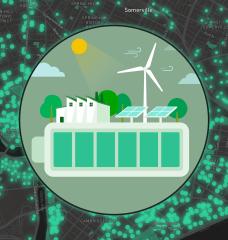
Caroline Jordan is a junior at MIT majoring in mechanical engineering. When she’s not in class, she spends her time running the MIT Solar Electric Vehicle team. MIT Climate sat down with Caroline to discuss her role as team captain, her research interests, and the designing and building processes involved in creating electric vehicles. If you’re interested in learning more about the team, you can check out their website here.
Mikaela: How did you get interested in solar-powered vehicles?
Caroline: Every year, the Edgerton Center Student Clubs and Teams at MIT holds an open house where all of the teams showcase their vehicles and technologies. It was at this event in my Freshman year that I first saw the team (and I believe the 2015 car, Arcturus) and was immediately hooked. I’m very interested in renewable energy technologies in general, and I like to focus on doing one thing well, and for me, that one thing is solar cars. Many of my most memorable MIT experiences have been with this team and this car (our 2017 model).
Mikaela: What is the design process like for a solar electric vehicle?
Caroline: For our team, we run on a 2-year design-build cycle. So, we are currently in year 1, which is the design year. During this year, each sub-team (we’re split into Mechanical, Aero/Composites, and Electrical) is designing for their deadlines. The 3rd party manufacturers we work with establish larger deadlines, for example we get our aero shell molds manufactured by a boat manufacturer in Maine. The manufacturing team leaders then set internal deadlines, with review from the executive team (the Systems Lead, Vice-Captain, and myself).
Throughout the design process, we are drawing and modeling different designs, performing hand calculations and higher-level analysis, as well as prototyping and testing different ideas. We also conduct design reviews for each component and system. These start amongst other team members and move up to alums and professional engineers as the designs approach their final state.
Mikaela: And when will these designs move into the building phase?
Caroline: The manufacturing process will begin for us in late May 2019. From May 25th - June 2nd we will be traveling to Bath, Maine to perform massive composite lay-ups on our outsourced molds. These lay-ups are to manufacture the outer body and chassis of the car. After this, we will bring the new car body and molds back to our shop at MIT. We will then begin the manufacturing of the mechanical and electrical systems for the car as well as the fix (using structural filler), sand, and paint the car body. Once the bodywork is finished, we lay our solar panels on the upper body of the car.
While these processes are happening, our mechanical engineers will be manufacturing and assembling the mechanical components. We do not begin testing the car until it is mechanically and electrically sound. The car will likely be drivable by the end of 2019.
As for testing, we have several levels of local testing that we put the car and drivers through, as well as taking the car on long road trips. These are also great for team bonding and learning more about race operations.
Mikaela: What has been the most rewarding part of being on the solar electric vehicle team?
Caroline: By far, the most rewarding moment of being on the team was finishing the race this past July. We placed 5th in the road race and ran the entire 1700-miles on solar power, the best our team has done in over a decade. Three years of ridiculously hard work by our team went into this car and this goal - I can’t really put into words the emotions of the team at the finish. It was beyond amazing.
Mikaela: What has been the most challenging part of being on the solar electric vehicle team?
Caroline: The most challenging part for me was also our race this past summer. There is a 4-day-long regulation verification period, called Scrutineering, which we barely passed. The team must pass Mechanical, Electrical, Battery, and Array Scrutineering before moving to Dynamic Scrutineering, which consists of timed slalom and brake tests. We did not pass Mechanical Scrutineering until the final day, giving us less than half a day to pass Dynamic Scrutineering.
Mikaela: What issues specifically did you run into during Scrutineering?
Our issues during Mechanical Scrutineering were primarily with the suspension. Our suspension was improperly constrained such that the full range-of-motion of the shock absorber was limited. This put a great deal of stress on our composite chassis, which delaminated as a result. We had to use a power tool called a dremel to remove part of a mount on all suspensions to fix the spring-travel issue as well as remove the suspensions to inject epoxy into the honeycomb (middle of the composite material) of the chassis.
We also ran into another issue during Mechanical Scrutineering: the bearings in our lower A-arms (horizontal support on the suspension) were improperly swaged (a method of joining metal pieces). We had to act very quickly and were miraculously able to acquire a swaging tool from a local machinist and borrow equipment from other teams to properly swage the bearings.
We then moved onto Dynamic Scrutineering. The slalom is very fast and the brake test is a hard, wet pavement test. We eventually passed the slalom test but had a ton of difficulty with the brake test. After what felt like 40 brake tests, a ton of stress and anxiety among the team, and an incredibly determined and resilient driver, we passed the brake test by 0.01 seconds. At this point, it was about 3 hours after they technically were supposed to end Scrutineering, but the officials are truly there for the teams, so they stayed to help us succeed.
After many long nights working on the car, a few all-nighters, and our very brilliant team members, we were able to debug all of our mechanical issues and pass Scrutineering on the final day. This was an extremely rough and stressful experience, but one I wouldn't trade for the world.
Mikaela: How can the production of solar electric vehicles be improved?
Caroline: I do think manufacturing of solar vehicles, in general, could be improved with advances in battery technology. Our batter is fairly massive, yet our car is pretty light, and I have seen batteries of heavier solar cars, which can get huge. A fun fact about our car is that it weighs 285 kg fully-laden (with driver and battery). With charging the battery 2 hours every morning and evening (and during driving), we were able to travel 1762.7 miles on only solar power!
Mikaela: How can we inspire and empower people to act on climate change?
Caroline: In the context of our team, we give many shop tours and info sessions to educate people about our technology. Our car isn’t a commercial vehicle, and we are designing to compete in a race. However, we can still inspire our team members and community members that sustainability and renewable energy are powerful and important through education.






